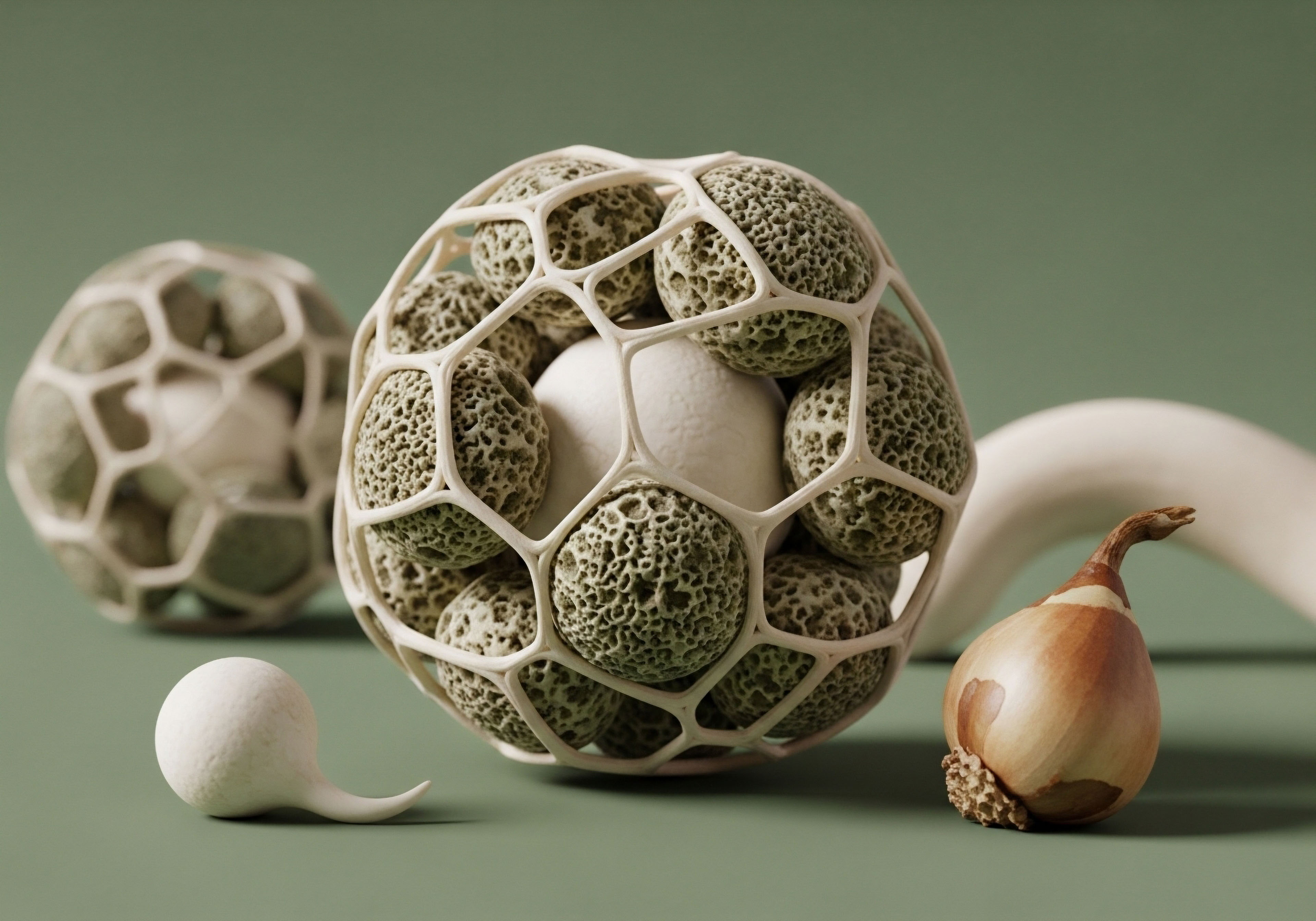

Fundamentals
Have you ever experienced that subtle, yet persistent, sensation of puffiness, a feeling of fullness in your hands, feet, or even your face, despite your best efforts to maintain a balanced lifestyle? This experience, often dismissed as a minor inconvenience, can signal deeper physiological shifts within your body’s intricate systems.
It is a signal from your internal environment, prompting a closer look at how your biological systems are communicating and regulating themselves. Understanding these signals marks the first step in reclaiming your vitality and optimal function.
Our bodies are remarkable orchestrators of balance, constantly adjusting to maintain a stable internal state. Among the many internal messengers guiding these processes, growth hormone (GH) plays a central role. This powerful polypeptide, produced by the pituitary gland, influences a wide array of bodily functions, from cellular repair and metabolic regulation to body composition and overall well-being.
As we age, the natural production of growth hormone often declines, leading to a cascade of changes that can impact how we feel and function. This decline can contribute to symptoms such as reduced muscle mass, increased body fat, and, pertinent to our discussion, alterations in fluid balance.
The concept of growth hormone peptides offers a targeted approach to supporting the body’s natural growth hormone production. These specialized amino acid sequences do not directly introduce synthetic growth hormone into the body. Instead, they act as secretagogues, gently stimulating the pituitary gland to release its own stored growth hormone.
This method respects the body’s inherent regulatory mechanisms, aiming to restore a more youthful and balanced endocrine environment. When considering how these peptides might influence fluid retention, it becomes essential to appreciate the delicate interplay between growth hormone, other hormones, and the body’s fluid management systems.
Fluid retention, often a subtle symptom, can indicate deeper physiological imbalances within the body’s regulatory systems.

Understanding Fluid Dynamics
The human body is composed primarily of water, distributed across various compartments, including intracellular fluid within cells and extracellular fluid outside cells. Maintaining the precise volume and composition of these fluid compartments is paramount for cellular function, nutrient transport, and waste removal. This delicate balance is governed by a complex network of physiological processes involving the kidneys, the cardiovascular system, and a symphony of hormones.
Key players in fluid regulation include antidiuretic hormone (ADH), also known as vasopressin, which controls water reabsorption in the kidneys, and the renin-angiotensin-aldosterone system (RAAS), which influences sodium and water balance, blood pressure, and potassium levels. When these systems operate in harmony, fluid levels remain stable. Disruptions, however, can lead to either dehydration or, as many experience, unwanted fluid retention.

How Hormones Influence Water Balance
Hormones act as the body’s internal messaging service, carrying instructions to various organs and tissues. When it comes to fluid balance, these messages are particularly critical. For instance, aldosterone, a hormone produced by the adrenal glands as part of the RAAS, signals the kidneys to retain sodium and, consequently, water. Conversely, atrial natriuretic peptide (ANP), released by the heart, promotes sodium and water excretion, acting as a counter-regulatory mechanism.
Growth hormone itself, and the peptides that stimulate its release, can influence these pathways. While growth hormone is renowned for its anabolic effects on muscle and bone, it also possesses properties that can affect renal function and electrolyte balance.
A slight increase in fluid retention can sometimes be an initial, transient effect as the body adapts to elevated growth hormone levels, a sign of its systemic influence rather than a pathological concern in many cases. This initial adjustment reflects the body’s recalibration to a more robust metabolic state.


Intermediate
For individuals seeking to optimize their physiological function, growth hormone peptide therapy represents a targeted strategy. These therapeutic agents work by enhancing the body’s own growth hormone secretion, rather than introducing exogenous hormones. The specific peptides utilized, such as Sermorelin, Ipamorelin, CJC-1295, Tesamorelin, and Hexarelin, each possess distinct mechanisms of action, yet all converge on the goal of stimulating the pituitary gland. Understanding their individual characteristics provides clarity on their potential effects, including their influence on fluid dynamics.
When considering the effects of growth hormone peptides on fluid retention, it is important to recognize that any changes are typically a consequence of the increased growth hormone and subsequent insulin-like growth factor 1 (IGF-1) levels. Growth hormone directly influences kidney function, particularly the glomerular filtration rate and renal plasma flow.
These changes can lead to a transient increase in sodium reabsorption, which in turn draws water into the extracellular space. This phenomenon is often mild and self-limiting as the body adapts to the new hormonal milieu.

Specific Growth Hormone Peptides and Their Actions
Different growth hormone-releasing peptides (GHRPs) and growth hormone-releasing hormone (GHRH) analogs interact with the pituitary gland in unique ways, leading to varying pulsatile release patterns of growth hormone.
- Sermorelin ∞ This peptide is a GHRH analog, mimicking the natural hormone that signals the pituitary to release growth hormone. Its action is physiological, promoting a pulsatile release that closely resembles the body’s endogenous rhythm. Fluid retention with Sermorelin is generally minimal due to its naturalistic release pattern.
- Ipamorelin and CJC-1295 ∞ Ipamorelin is a selective GHRP, meaning it stimulates growth hormone release without significantly impacting other hormones like cortisol or prolactin. CJC-1295 is a GHRH analog with a drug affinity complex (DAC), extending its half-life and providing a more sustained growth hormone release. When combined, Ipamorelin and CJC-1295 offer a potent, sustained elevation of growth hormone. The more consistent elevation of growth hormone with CJC-1295/Ipamorelin can sometimes lead to a slightly more noticeable, though still typically mild and transient, fluid retention compared to Sermorelin, particularly during the initial weeks of therapy.
- Tesamorelin ∞ This GHRH analog is specifically approved for reducing visceral adipose tissue in HIV-associated lipodystrophy. Its mechanism involves stimulating growth hormone release, which in turn influences fat metabolism. Clinical trials with Tesamorelin have reported fluid retention as a common, yet usually mild, side effect, consistent with its sustained growth hormone-releasing properties.
- Hexarelin ∞ A potent GHRP, Hexarelin stimulates growth hormone release through a mechanism similar to ghrelin. It is known for its robust growth hormone secretion, which can sometimes be accompanied by a more pronounced, albeit temporary, fluid retention compared to other peptides, reflecting its powerful impact on the pituitary.
- MK-677 (Ibutamoren) ∞ While not a peptide, MK-677 is a non-peptide growth hormone secretagogue that orally stimulates growth hormone release. Its sustained action can lead to consistent elevations in growth hormone and IGF-1. Users of MK-677 often report mild to moderate fluid retention, particularly in the extremities, as a common initial effect, which tends to subside with continued use.
Growth hormone peptides stimulate the body’s own growth hormone release, with any fluid retention typically being a mild, transient adaptation to increased hormonal levels.

Managing Fluid Balance during Peptide Therapy
The experience of fluid retention during growth hormone peptide therapy is often a temporary physiological adjustment. It is a sign that the body is responding to the increased growth hormone signaling. For most individuals, this effect is mild and resolves spontaneously within a few weeks as the body equilibrates. However, proactive strategies can help manage any discomfort.
A balanced approach to hydration and electrolyte intake is fundamental. Ensuring adequate water consumption helps the kidneys process and excrete excess fluids efficiently. Dietary considerations also play a role; moderating sodium intake can mitigate fluid accumulation, while ensuring sufficient potassium intake supports proper cellular fluid balance. Regular physical activity also aids in circulation and fluid mobilization.
For those undergoing Testosterone Replacement Therapy (TRT) concurrently, whether male or female, the interplay of hormones becomes even more intricate. In men receiving TRT, particularly with Testosterone Cypionate, careful monitoring of estrogen conversion is vital. Elevated estrogen levels can independently contribute to fluid retention.
Medications like Anastrozole, used to manage estrogen, can therefore indirectly help mitigate fluid retention in this context. Similarly, in women on low-dose Testosterone Cypionate or pellet therapy, maintaining overall hormonal balance, including progesterone levels, is important for fluid regulation.

Comparing Peptide Effects on Fluid Retention
The degree of fluid retention can vary among different growth hormone peptides, largely depending on their potency and the duration of their growth hormone-releasing effect.
| Peptide/Agent | Mechanism of Action | Typical Fluid Retention Profile | Duration of GH Elevation |
|---|---|---|---|
| Sermorelin | GHRH analog, pulsatile release | Minimal, transient | Short (hours) |
| Ipamorelin / CJC-1295 | GHRP + GHRH analog (DAC) | Mild to moderate, transient | Sustained (days) |
| Tesamorelin | GHRH analog | Mild, common, transient | Sustained (days) |
| Hexarelin | Potent GHRP | Potentially more noticeable, transient | Moderate (hours) |
| MK-677 (Ibutamoren) | Non-peptide GH secretagogue | Mild to moderate, common, transient | Sustained (24 hours) |
This table illustrates that peptides offering a more sustained elevation of growth hormone, such as CJC-1295/Ipamorelin and MK-677, might induce a slightly more noticeable initial fluid shift. This is a physiological response, not typically a cause for concern, and it underscores the importance of personalized clinical guidance to monitor and adjust protocols as needed.


Academic
The influence of growth hormone and its stimulating peptides on fluid retention represents a complex interplay within the neuroendocrine and renal systems. While often perceived as a minor side effect, understanding the underlying physiological mechanisms provides a deeper appreciation for the systemic reach of growth hormone signaling.
The transient nature of this fluid shift in most individuals points to a homeostatic adaptation rather than a pathological state, yet a rigorous examination of the pathways involved is warranted for comprehensive clinical insight.
At the cellular level, growth hormone exerts its effects both directly and indirectly, primarily through the mediation of insulin-like growth factor 1 (IGF-1), synthesized predominantly in the liver. Both GH and IGF-1 receptors are present in renal tissues, including the glomeruli and renal tubules.
Activation of these receptors can lead to alterations in renal hemodynamics and tubular transport. Specifically, growth hormone has been shown to increase the glomerular filtration rate (GFR) and renal plasma flow (RPF), leading to an expansion of extracellular fluid volume. This expansion is often attributed to enhanced sodium reabsorption in the proximal tubules and collecting ducts.

Growth Hormone and Renal Sodium Handling
The precise mechanisms by which growth hormone influences renal sodium handling are multifaceted. Research indicates that growth hormone can directly stimulate the activity of the sodium-potassium ATPase pump in renal tubular cells. This enzyme is critical for maintaining sodium gradients across cell membranes, and its increased activity leads to greater sodium reabsorption from the tubular lumen back into the bloodstream. This reabsorption of sodium is osmotically coupled with water, meaning water follows sodium, thereby increasing extracellular fluid volume.
Beyond direct tubular effects, growth hormone also interacts with key hormonal systems that regulate fluid and electrolyte balance. The renin-angiotensin-aldosterone system (RAAS) is a primary regulator of blood pressure and fluid volume. While some studies suggest growth hormone might suppress plasma renin activity, others indicate a more complex interaction, potentially leading to increased aldosterone secretion in certain contexts. Aldosterone, a potent mineralocorticoid, directly promotes sodium reabsorption and potassium excretion in the kidneys, contributing to fluid retention.
Growth hormone influences renal sodium handling by increasing sodium-potassium ATPase activity and interacting with the renin-angiotensin-aldosterone system.

The Role of Antidiuretic Hormone and Aquaporins
Another critical component in fluid regulation is antidiuretic hormone (ADH), or vasopressin, which controls water permeability in the renal collecting ducts. Growth hormone has been shown to influence ADH secretion and sensitivity. Elevated growth hormone levels can sometimes lead to an increase in ADH activity, promoting greater water reabsorption independently of sodium. This effect is mediated, in part, by changes in the expression or function of aquaporin channels, particularly aquaporin-2, which are responsible for water transport across renal cell membranes.
The initial fluid retention observed with growth hormone peptide therapy can therefore be viewed as a physiological adaptation to an expanded extracellular fluid volume, driven by a combination of increased renal sodium reabsorption and altered water handling. This adaptive phase typically stabilizes as the body establishes a new homeostatic set point for fluid balance.

Individual Variability and Clinical Considerations
Why do some individuals experience more noticeable fluid retention than others when undergoing growth hormone peptide therapy?
Individual responses to growth hormone peptides can vary significantly, influenced by genetic predispositions, baseline hormonal status, and concurrent medical conditions. Polymorphisms in genes encoding components of the RAAS or aquaporin channels could modulate an individual’s susceptibility to fluid shifts. Furthermore, pre-existing conditions such as subclinical hypothyroidism or adrenal dysfunction, which independently affect fluid balance, might exacerbate fluid retention in the presence of elevated growth hormone levels.
For instance, in men undergoing Testosterone Replacement Therapy (TRT), the management of estrogen levels becomes a critical consideration. Testosterone aromatizes into estrogen, and elevated estrogen can independently promote fluid retention by influencing the RAAS and ADH pathways.
Therefore, in a male patient receiving both TRT and growth hormone peptides, careful monitoring of estradiol levels and the judicious use of an aromatase inhibitor like Anastrozole may be necessary to mitigate excessive fluid accumulation. This integrated approach underscores the importance of viewing the endocrine system as an interconnected network.

Fluid Balance Markers and Monitoring
Clinical monitoring of fluid balance during growth hormone peptide therapy involves assessing both subjective symptoms and objective markers.
How Do Growth Hormone Peptides Affect Renal Sodium Reabsorption?
| Marker | Clinical Relevance | Typical Changes with GH/Peptide Therapy |
|---|---|---|
| Body Weight | General indicator of fluid status | Initial slight increase, then stabilization |
| Blood Pressure | Cardiovascular fluid load | Usually stable, minor fluctuations possible |
| Serum Sodium | Electrolyte balance | Typically maintained within normal range |
| Serum Aldosterone | RAAS activity | Variable, potentially slight increase |
| Urinary Sodium Excretion | Renal sodium handling | May decrease initially, then normalize |
| Creatinine Clearance | Glomerular filtration rate | Often increases, reflecting enhanced renal function |
Monitoring these parameters allows clinicians to differentiate between a benign physiological adaptation and a more significant fluid imbalance. The goal is always to optimize the therapeutic benefits of growth hormone peptides while ensuring patient comfort and safety.
What Is The Interplay Between Growth Hormone Peptides And The Renin-Angiotensin-Aldosterone System?
The interaction between growth hormone and the RAAS is a subject of ongoing research. While growth hormone can stimulate components of the RAAS, the overall effect on blood pressure and fluid volume is often buffered by counter-regulatory mechanisms. The body’s ability to adapt to changes in hormonal signaling is a testament to its inherent resilience.
Can Growth Hormone Peptides Influence Aquaporin Channel Expression In Renal Tubules?
Indeed, the influence of growth hormone on aquaporin channels, particularly aquaporin-2, is a fascinating area of study. Changes in the expression or trafficking of these water channels can directly impact the kidney’s ability to reabsorb water, contributing to the fluid shifts observed. This molecular-level insight underscores the deep biological mechanisms at play.

References
- Frohman, Lawrence A. and J. L. Jameson. “Growth Hormone-Releasing Hormone.” In DeGroot’s Endocrinology, edited by J. Larry Jameson and Leslie J. DeGroot, 7th ed. 2016.
- Molitch, Mark E. “Growth Hormone Deficiency in Adults.” In Endocrinology ∞ Adult and Pediatric, edited by J. Larry Jameson and Leslie J. DeGroot, 7th ed. 2016.
- Norbiato, G. et al. “Growth hormone, fluid balance and sodium metabolism.” Journal of Endocrinological Investigation 22, no. 5 (1999) ∞ 377-384.
- Sassone-Corsi, Paolo, and Joseph S. Takahashi. “Circadian rhythms and metabolism ∞ from genes to physiology.” Science 341, no. 6148 (2013) ∞ 1235893.
- Veldhuis, Johannes D. et al. “Growth hormone (GH) pulsatility in humans ∞ a review of the mechanisms and physiological implications.” Growth Hormone & IGF Research 16, no. 1 (2006) ∞ S1-S12.
- Wass, John A. H. and Michael O. Thorner. Oxford Textbook of Endocrinology and Diabetes. 3rd ed. Oxford University Press, 2011.
- Yuen, Kevin C. J. et al. “Fluid retention in adult growth hormone deficiency ∞ a review of the literature.” Pituitary 16, no. 3 (2013) ∞ 389-399.
- Zarate, A. et al. “Effects of growth hormone on renal function.” Journal of Endocrinological Investigation 22, no. 5 (1999) ∞ 385-390.

Reflection
As we conclude our exploration of growth hormone peptides and their influence on fluid retention, consider this ∞ your body is a dynamic, responsive system, constantly striving for equilibrium. The sensations you experience, whether subtle puffiness or a renewed sense of vitality, are direct communications from this internal landscape. Understanding these signals, not as isolated events, but as interconnected elements within your broader endocrine and metabolic symphony, is a powerful act of self-discovery.
This knowledge is not merely academic; it is a foundation for personal agency. It invites you to approach your health journey with informed curiosity, recognizing that personalized wellness protocols are built upon a deep respect for your unique biological blueprint.
The path to reclaiming optimal function is often a process of careful observation, thoughtful adjustment, and a collaborative partnership with clinical guidance. May this deeper understanding serve as a catalyst for your continued pursuit of well-being, empowering you to navigate your physiological landscape with confidence and clarity.



